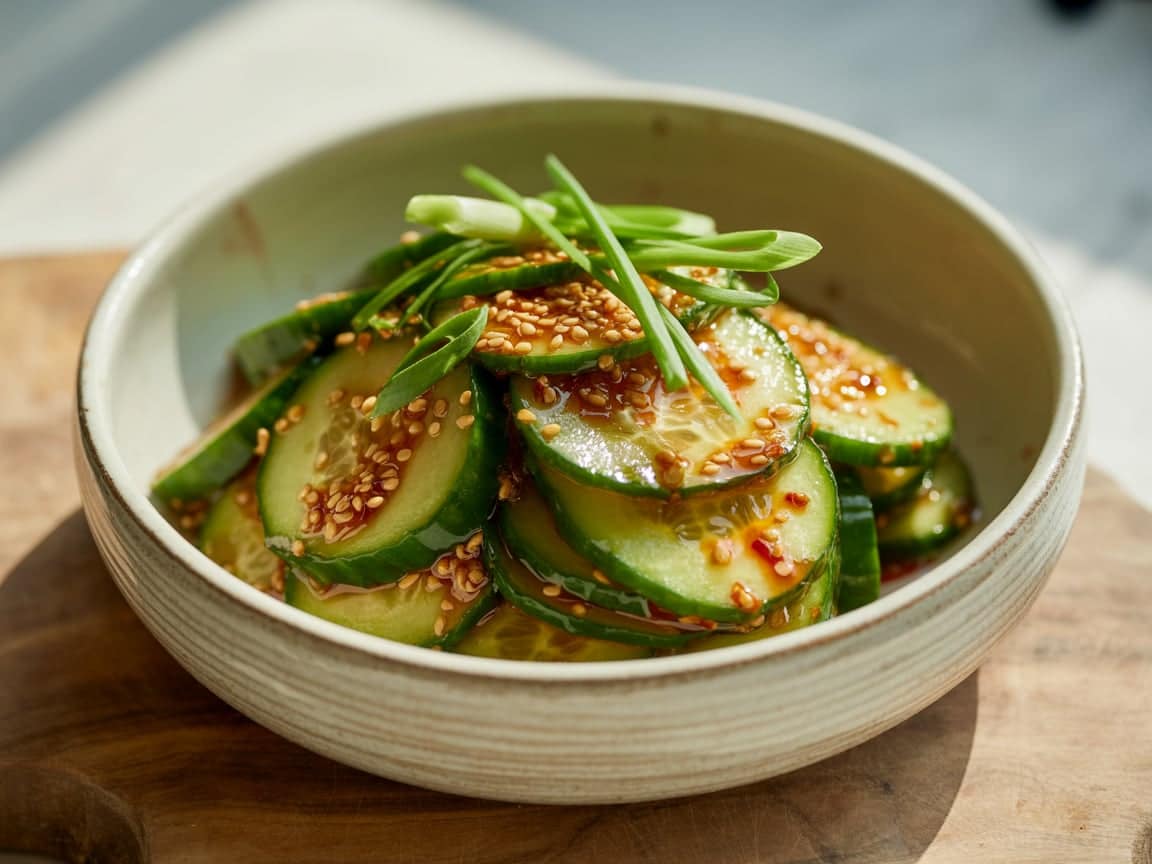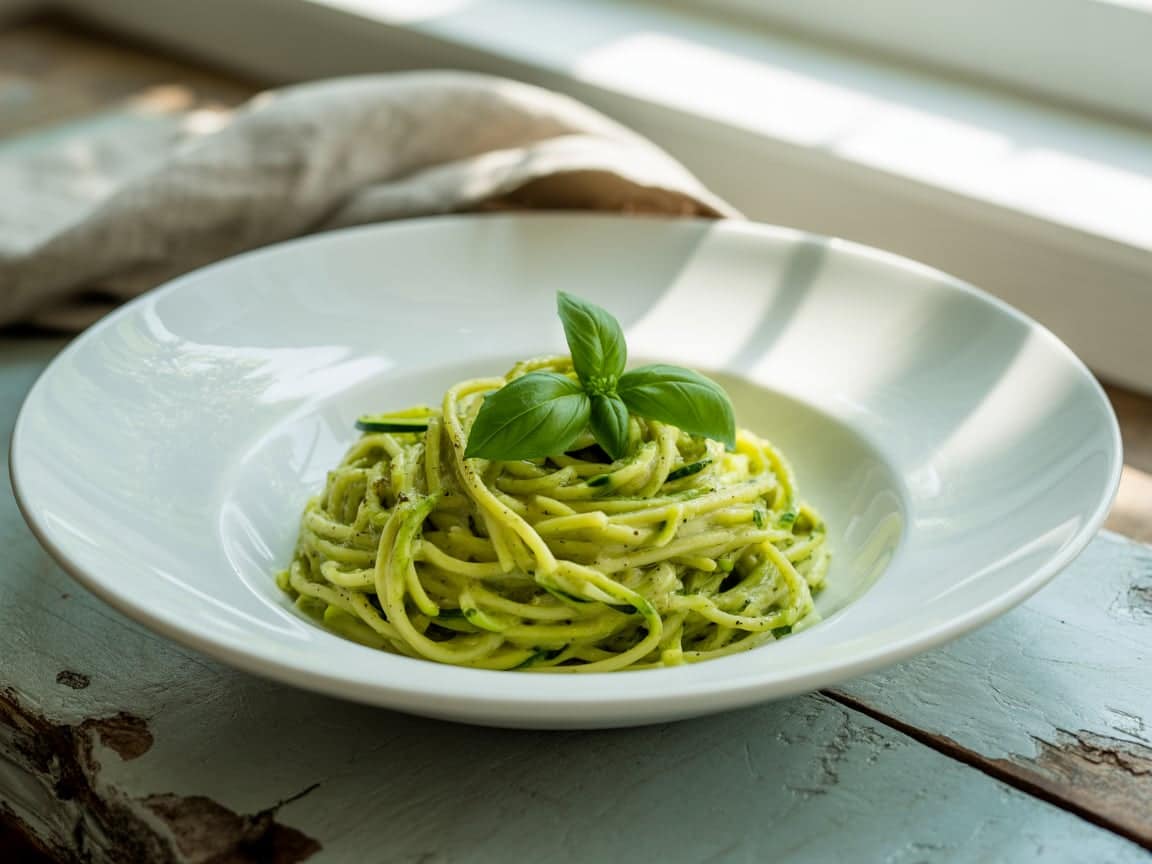Baked corned beef cabbage is more than just a holiday favorite—it’s a heartwarming dish that brings generations together around the dinner table. Here at CozyBitesRecipes.com, I believe comfort food should be both simple and unforgettable. Inspired by my grandmother’s home-cooked traditions and my own journey as a mom who finds joy in creating nourishing meals, this recipe is a love letter to cozy kitchen moments and family connection.
From my childhood spent helping Grandma with Sunday roasts to the laughter shared with my kids over weeknight dinners, I’ve always seen food as a bridge—linking love, legacy, and the joy of feeding the people you care about. That’s exactly what you’ll get with this baked corned beef cabbage recipe: a soul-satisfying, melt-in-your-mouth classic. Unlike the traditional boiled version, this baked corned beef cabbage is oven-roasted for extra flavor, tender texture, and crispy edges that elevate every bite. If you’re craving comfort food that’s both nostalgic and simple to make, baked corned beef cabbage delivers on every level.
Check out our protein-packed twist on sushi casseroles like High Protein Sushi Bake Recipe if you’re craving other hearty oven-baked creations after this one.
Whether you’re prepping for St. Patrick’s Day, craving a nostalgic dinner, or trying corned beef for the first time, this guide will walk you through every step of the process—from selecting the best cut to seasoning tricks and veggie pairings. So grab your baking dish, preheat the oven, and let’s get cooking something truly special.
Table of Contents
Why Baked Corned Beef Cabbage Is a Timeless Classic
The cultural history of corned beef and cabbage
Baked corned beef cabbage may not be a traditional Irish dish, but it has become a beloved symbol of Irish-American heritage. When Irish immigrants came to the U.S. in the 1800s, they adopted beef brisket—more affordable than pork—and paired it with cabbage, a common staple. The result? A hearty, budget-friendly meal that stuck. Today, baked corned beef cabbage is enjoyed every March 17th and beyond for its comforting flavor and simple prep.
While boiling was once the go-to, many home cooks now prefer making baked corned beef cabbage in the oven. This method delivers tender, sliceable meat and roasted cabbage with deeper flavor—without the need to babysit a stovetop pot.
Why the oven-baked method stands out from others
While boiling or slow cooking is traditional, baked corned beef cabbage offers deeper flavor and a more hands-off cooking experience. Oven-roasting helps form a caramelized crust on the brisket, while foil-wrapping or baking in a covered dish locks in moisture for tender results. Best of all, you can roast the cabbage, carrots, and potatoes right alongside the meat—making baked corned beef cabbage a true one-dish meal that’s big on taste and low on hassle.
Roasting also gives you more control over seasoning, from brown sugar and mustard glazes to spice rubs filled with garlic, pepper, and clove. With its rich aroma, texture, and ease, baked corned beef cabbage is a flavorful upgrade to the classic.
Discover great ideas like this warm, savory brunch bake in our Brussel Sprouts and Ham Quiche recipe that follows similar comforting principles.
Choosing the Best Cut of Corned Beef for Oven-Baking
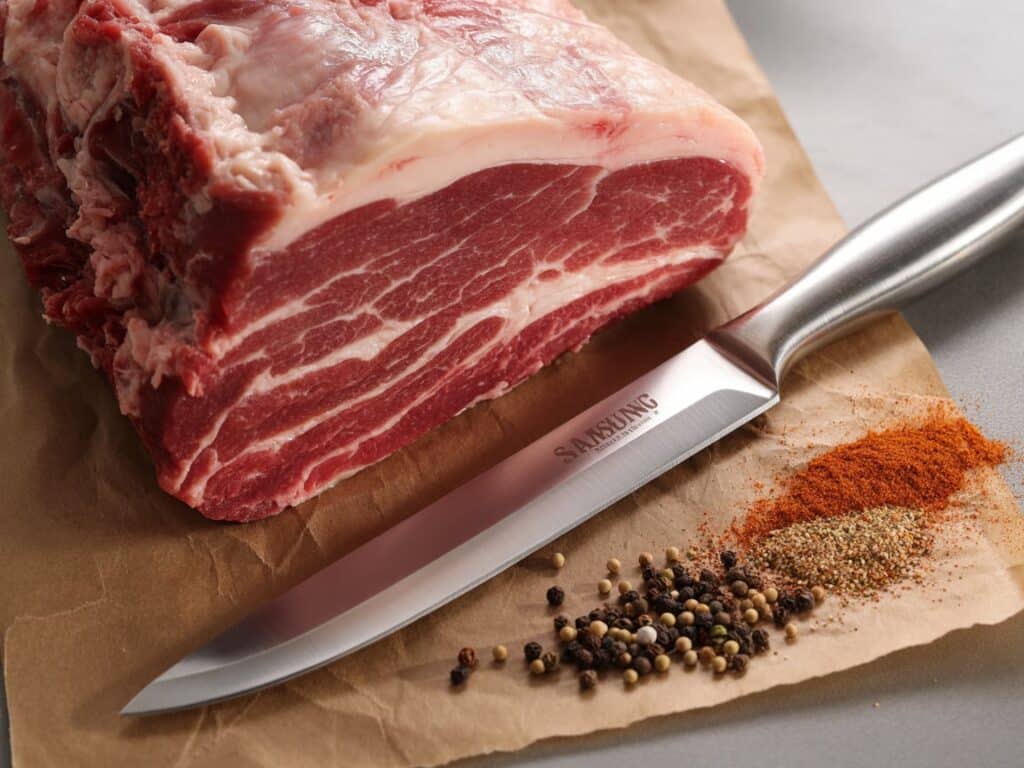
Flat cut vs. point cut: What’s better for baking?
When it comes to making the perfect baked corned beef cabbage, the cut you choose plays a huge role in flavor, texture, and final results. Corned beef typically comes in two main cuts: flat cut and point cut.
The flat cut (also known as the “first cut”) is leaner and more uniform, making it the ideal choice for baked corned beef cabbage. It cooks evenly, slices cleanly, and stays juicy when roasted low and slow. Because of its shape and thickness, it delivers consistently tender slices—perfect for serving with roasted cabbage and veggies.
In contrast, the point cut (or “second cut”) is fattier and more flavorful but tends to shrink more and shred instead of slice. If you’re planning to pull the meat rather than slice it, the point cut can work—but for classic baked corned beef cabbage served in thick, hearty slices, flat cut is the way to go.
Pro tip: Ask your butcher for a trimmed flat cut between 3 to 4 pounds—it’s the perfect size for an oven roast that feeds a crowd and makes great leftovers.
Where to buy high-quality corned beef brisket
For a standout baked corned beef cabbage dish, quality matters. While supermarkets carry pre-brined corned beef around St. Patrick’s Day, don’t settle for the first one you see. Look for briskets that are:
- Vacuum-sealed with visible spice packets
- Even in thickness (to cook evenly in the oven)
- Deep pink in color (a sign of good curing)
If you can, buy from a local butcher, where you can often get a fresher brisket and ask about the brining process. Some artisanal shops even brine their own beef in-house with fewer preservatives and more natural flavors.
And if you’re planning ahead, online meat suppliers like Crowd Cow, Porter Road, or local farms often ship high-grade corned beef directly to your door.
Looking for inspiration? Try this Southwest-style bean delight that’s great for pairing with baked meats: Southwest Dense Bean Salad.
Prepping Corned Beef for the Oven
Should you rinse corned beef before cooking?
Absolutely—and here’s why. Corned beef is cured in a salty brine that deeply penetrates the meat. While this curing process adds flavor and preserves the beef, it also leaves behind excess surface salt. If you skip rinsing, your baked corned beef cabbage might turn out overly salty—even if you haven’t added any extra seasoning.
To rinse corned beef correctly:
- Remove the meat from its packaging.
- Rinse it under cold running water for 1–2 minutes.
- Pat it dry with paper towels.
Don’t worry—rinsing won’t wash away the flavor locked into the meat. It simply helps balance the saltiness for a more mellow, oven-roasted bite.
What happens if you don’t rinse it? The salt content can dominate the final flavor, and it may even affect the texture of your baked vegetables if they’re in the same pan.
How to trim and season corned beef for baking perfection
While most store-bought corned beef briskets come pre-brined and pre-seasoned, you still have a few options to boost flavor before baking.
Trimming
Leave a thin layer of fat on top of the brisket. This will melt and baste the beef during baking, keeping it moist and flavorful. If there’s an overly thick fat cap, trim it down to about 1/4 inch.
Seasoning Options
You can go two ways with seasoning:
- Use the included spice packet – usually contains mustard seeds, peppercorns, coriander, bay leaf, and other pickling spices.
- Make your own rub with a twist. Try mixing:
- 2 tbsp brown sugar
- 1 tbsp Dijon mustard
- 1 tsp garlic powder
- 1 tsp black pepper
- Optional: 1/2 tsp smoked paprika for depth
Rub this mixture over the rinsed, patted-dry brisket before baking. It helps create a caramelized crust in the oven and balances the savory brine.
For an even heartier pairing later, don’t miss our hearty casserole-style veggie dinner: Mexican Vegetarian Cheese Jiffy Corn Bread Casserole
The Perfect Way to Bake Corned Beef in the Oven
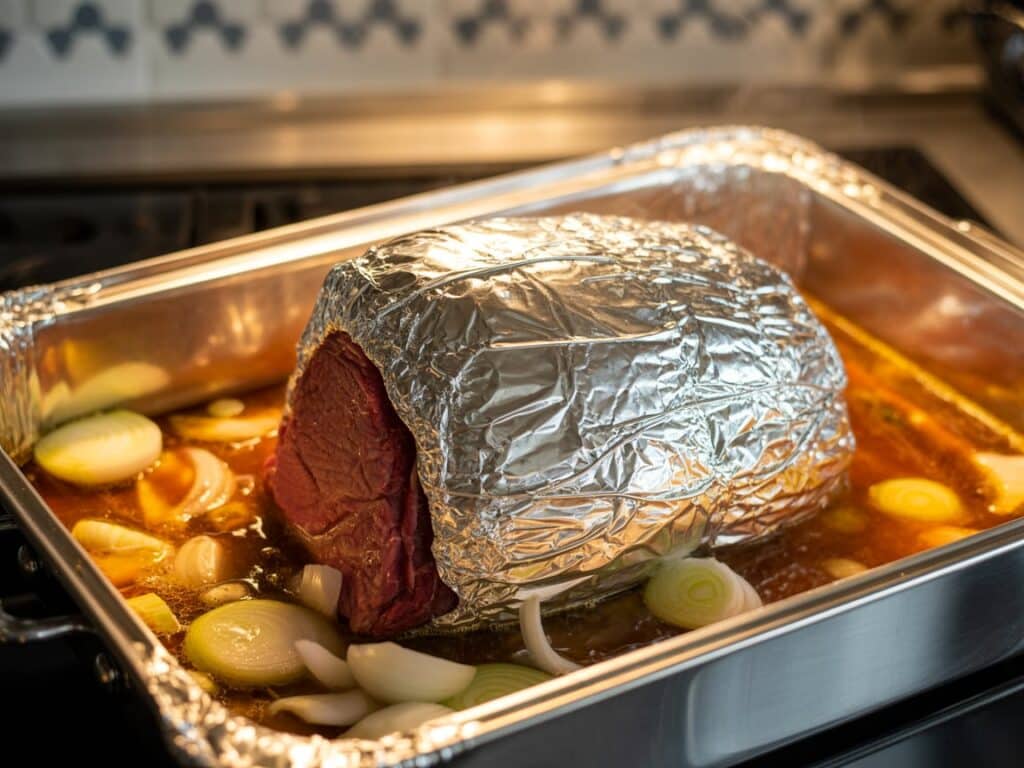
Best oven temperature and time for tender corned beef
When baking corned beef, low and slow wins the race. That’s the secret to a fork-tender brisket with rich flavor and melt-in-your-mouth texture.
Here’s the golden rule for baking corned beef:
| Weight of Corned Beef | Oven Temp | Baking Time |
|---|---|---|
| 3 lbs | 300°F | 3 hours |
| 3.5–4 lbs | 300°F | 3.5–4 hours |
| 4.5+ lbs | 300°F | 4.5–5 hours |
Steps for baking:
- Preheat oven to 300°F (150°C).
- Place rinsed and seasoned corned beef fat-side up in a roasting pan or deep baking dish.
- Add about 1 inch of water, broth, or a mix of both to the bottom of the dish.
- Cover the pan tightly with aluminum foil or a fitted lid.
- Bake in the center rack for 3–4.5 hours depending on size.
For extra moisture and flavor, many home cooks add sliced onions, a splash of beer, or a few garlic cloves to the liquid.
You’ll know it’s ready when the beef reaches an internal temperature of 195°F to 205°F and is tender when pierced with a fork.
How to wrap, cover, or bake uncovered for best moisture retention
For the best baked corned beef cabbage, cover it up. This isn’t a brisket you want to dry-roast—corned beef thrives in a moist environment. Covering your baking dish with foil traps steam and heat, allowing the meat to gently break down and stay juicy throughout the cooking process.
If you’re craving a crispy crust, uncover your baked corned beef cabbage during the last 15 minutes. Brush the top with mustard or a brown sugar glaze, then broil for 3–5 minutes for a caramelized finish that adds flavor and texture.
Avoid baking it uncovered the entire time, as this will likely result in dry, tough meat. The only time to skip covering is if you’re deliberately going for a firmer texture—like when preparing thin-sliced baked corned beef cabbage for sandwiches or meal prep.
Need a protein-packed side dish that also bakes beautifully? Don’t miss this orphan gem: High Protein Dense Bean Salad
Cabbage, Carrots, and Potatoes – The Essential Sides
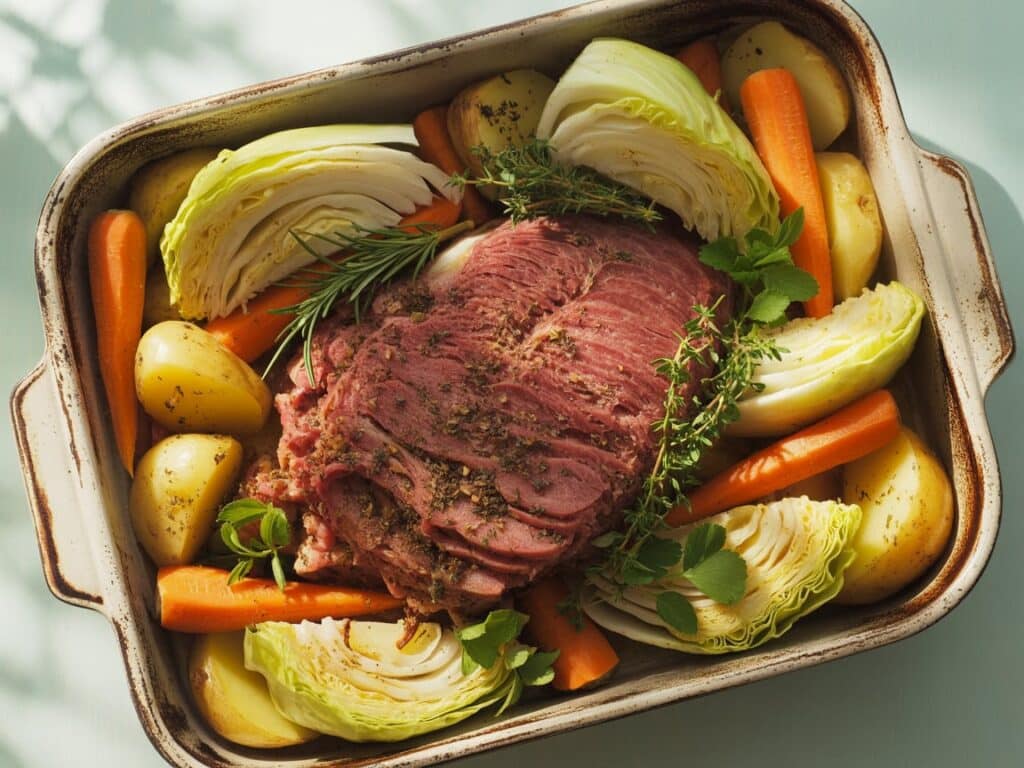
When and how to add cabbage to baked corned beef
No baked corned beef cabbage dish is complete without that signature tender, slightly sweet cabbage. But adding it at the wrong time can leave it either mushy or underdone.
When to add cabbage:
- Add cabbage wedges or large chunks to the roasting pan during the last 45–60 minutes of baking.
- This gives them time to soften and absorb flavor from the brisket and pan juices without becoming soggy.
How to prep cabbage:
- Use green cabbage, sliced into 4–6 wedges. Keep the core intact—it holds the leaves together as they bake.
- Toss them lightly with olive oil and salt before placing them around the beef. For a flavor boost, brush them with a glaze of mustard and honey in the final 10 minutes.
You can nestle the cabbage into the cooking liquid or place them slightly elevated for a more roasted edge.
Bonus Tip: Leftover roasted cabbage is excellent in grilled sandwiches with shredded corned beef and melted Swiss.
Roasting vegetables in the same pan: tips and tricks
Corned beef isn’t the only thing that benefits from oven time—adding carrots and potatoes transforms this into a one-pan feast.
Best veggies for roasting with corned beef:
- Carrots: Peel and cut into 2-inch chunks.
- Baby potatoes or Yukon Golds: Halve or quarter them. Leave skins on for rustic texture.
- Optional: Add parsnips or rutabaga for depth.
When to add veggies:
- Like cabbage, root vegetables go in about 60–90 minutes before the corned beef is done.
- Toss them in a mix of olive oil, salt, pepper, and a bit of thyme before arranging them around the brisket.
Cooking Hack: Keep veggies partially submerged in the pan juices for tender centers and browned tops.
Don’t miss our flavor-packed, aromatic addition: Lemon Balm Recipe—it makes a bright, herbal contrast when finely chopped and sprinkled on finished veggies.
Flavor Variations and Seasoning Ideas
Mustard-glazed, brown sugar, or garlic-spiced: Flavor profiles
While the traditional corned beef spice packet works just fine, baking opens the door to more creative seasoning. Adding a glaze or rub just before or during the final bake can elevate your baked corned beef cabbage into something extraordinary.
Here are 3 crowd-pleasing flavor profiles:
1. Brown Sugar Mustard Glaze
- 3 tbsp brown sugar
- 1 tbsp Dijon or whole grain mustard
- 1 tsp apple cider vinegar
- Combine and brush on the top 15–20 minutes before baking ends. Broil for 3 minutes for a sticky finish.
2. Garlic & Herb Crust
- 1 tbsp olive oil
- 4 cloves minced garlic
- 1 tsp dried rosemary
- 1 tsp black pepper
- Massage over the top after rinsing, then bake as normal. Creates a savory crust.
3. Beer-Braised Style
- Replace the water in your roasting pan with a bottle of dark beer (like stout or porter).
- Add 1 tsp brown sugar to balance bitterness.
- Seal tightly and bake as usual.
Classic Irish seasonings to enhance the oven-baked dish
If you want to honor the Irish-American roots of this dish while sticking with simplicity, consider these classic seasonings:
- Bay leaves: Add 2–3 to the roasting liquid for earthy aroma.
- Mustard seeds & coriander: Present in most spice packets; toast a few extra to intensify flavor.
- Cloves or allspice berries: A warm, nostalgic touch—use sparingly (1–2 per brisket).
- Black peppercorns: For depth and boldness, crack slightly for a spicier edge.
These traditional spices work beautifully with the baked method because they release their oils slowly, infusing both the meat and vegetables.
Want a savory brunch twist later using leftovers? Check out this flavor-forward bake: Brussel Sprouts and Ham Quiche
Serving and Storing Leftovers
Best way to slice corned beef for serving
Once your corned beef is beautifully baked and rested, it’s time to slice—but don’t just grab a knife and go. The direction you slice makes a big difference in texture.
Here’s how to do it right:
- Let the corned beef rest for at least 15–20 minutes after taking it out of the oven. Tent it loosely with foil to keep warm.
- Place the brisket on a cutting board and locate the grain (the lines of muscle fibers running across the meat).
- Slice against the grain, not with it. This shortens the fibers, making each bite more tender.
- Use a sharp carving knife and cut into 1/4-inch slices for optimal chew and moisture retention.
Serve each slice with cabbage, carrots, and potatoes for a complete oven-roasted plate of comfort.
Reheating without drying: Leftover tips and recipes
The beauty of baked corned beef cabbage is that leftovers are just as delicious the next day—if you store and reheat them properly.
Storing Tips:
- Wrap leftovers in foil or place in airtight containers.
- Store vegetables separately from the meat to preserve texture.
- Refrigerate for up to 4 days, or freeze for up to 2 months.
Reheating Methods:
- Oven: Wrap slices in foil with a splash of broth. Bake at 300°F for 10–15 minutes.
- Stovetop: Heat gently in a skillet with a bit of water or butter, covered.
- Microwave: Use 50% power and cover with a damp paper towel to avoid drying out.
Leftover Recipe Ideas:
- Corned Beef Hash: Dice and sauté with potatoes and onions for a savory breakfast.
- Grilled Reubens: Layer with Swiss, sauerkraut, and Thousand Island on rye.
- Cabbage Soup: Chop leftovers into broth with carrots, garlic, and diced tomatoes.
Don’t miss our protein-rich comfort casserole, perfect for transforming your next dinner: Mexican Vegetarian Cheese Jiffy Corn Bread Casserole
Common Mistakes to Avoid When Baking Corned Beef
Dry beef, mushy cabbage, or overcooked veggies
Even experienced home cooks can fall into a few traps when preparing baked corned beef cabbage. Avoid these common mistakes, and you’ll end up with a dish that’s moist, flavorful, and balanced from top to bottom.
Mistake #1: Baking at too high a temperature
High heat is the enemy of tender baked corned beef cabbage. Roasting above 300°F can cause the brisket to shrink, toughen, and dry out. Stick to a low, slow roast—around 300°F—to let the collagen and fat break down gradually for melt-in-your-mouth results.
Mistake #2: Not covering the brisket properly
Moisture is key for perfect baked corned beef cabbage. Skipping the foil or lid allows steam to escape, leading to a dry roast. Always cover the pan tightly during the full bake time to keep the brisket juicy and tender.
Mistake #3: Adding cabbage too early
In baked corned beef cabbage, timing matters—especially for the veggies. Add the cabbage during the last 45–60 minutes to prevent it from turning mushy. Cut it into large wedges so it holds its shape and texture.
Mistake #4: Uneven veggie cuts
Choppy prep equals uneven cooking. For baked corned beef cabbage, be sure to cut carrots and potatoes into uniform 2-inch chunks. This ensures everything roasts evenly and finishes at the same time.
What happens if you skip rinsing or cook it too hot?
Skipping the rinse
Corned beef is cured in a salty brine, and if you skip rinsing it before cooking, your baked corned beef cabbage may end up overwhelmingly salty. While rinsing doesn’t affect the meat’s internal flavor, it removes excess surface salt that can throw off the balance—especially when you’re roasting it with delicate veggies like cabbage and potatoes.
Cooking too hot
One of the fastest ways to ruin baked corned beef cabbage is by cranking up the oven temperature. While it might speed things up, high heat toughens the brisket and leads to stringy, dry slices. For tender, sliceable meat with rich flavor, always roast low and slow—300°F is the sweet spot for that perfect oven-baked texture.
Need a refreshing beverage to pair with your cozy dinner? Check out this bright and flavorful drink idea: Cranberry Pomegranate Juice
FAQs About Baked Corned Beef Cabbage
How long do you leave corned beef in the oven?
The baking time depends on the size of your brisket, but a good rule of thumb is 1 hour per pound at 300°F (150°C). For example, a 3.5 lb corned beef will take approximately 3.5 to 4 hours. Always check with a meat thermometer—when it hits an internal temperature of 195°F to 205°F, it’s perfectly tender and ready to rest.
Is it better to cook corned beef in the oven or on the stove?
Both methods work well, but baking corned beef in the oven has some clear advantages:
It develops a delicious crust.
You can add vegetables in the same pan.
It’s more hands-off and consistent with temperature.
The stove method is quicker but often results in less flavorful veggies and requires more monitoring.
If you’re after caramelized edges, tender beef, and an all-in-one dish, oven-baked is the better pick.
What happens if you don’t rinse corned beef before cooking?
Skipping the rinse step means your brisket may come out over-salted. The curing brine contains a heavy dose of salt and spices, which can overwhelm the meat and the veggies cooked with it. Rinsing doesn’t strip away the flavor—it just removes excess salt from the surface and makes your final result more balanced and palatable.
How do I keep corned beef from drying out in the oven?
To keep baked corned beef moist and tender:
Cook it low and slow at 300°F.
Always cover it with foil or a lid to trap moisture.
Add a cup of broth or water to the pan to steam it gently.
Let it rest for 15–20 minutes after baking to retain juices before slicing.
Also, avoid slicing too thin or against the grain—that can cause the meat to lose moisture quickly when served.
Conclusion About Baked Corned Beef Cabbage
Baked corned beef cabbage is more than a once-a-year tradition—it’s a timeless comfort dish that brings people together. From selecting the right cut of beef to layering flavors with classic seasonings and oven-roasted veggies, this recipe makes it easy to create something hearty, wholesome, and unforgettable.
Whether you’re prepping for St. Patrick’s Day or simply craving a soulful, comforting dish, baked corned beef cabbage checks all the boxes—rich flavor, simple prep, and leftovers that taste even better the next day as the flavors deepen.
Don’t miss our refreshing and easy drink pairing for cozy dinners: Cranberry Pomegranate Juice
Now that you’ve got the technique down, it’s time to make baked corned beef cabbage your own. Add a tangy glaze, experiment with spice blends, or toss in seasonal vegetables to roast alongside the brisket. However you choose to personalize it, baked corned beef cabbage is a cozy, flavorful meal worth repeating all year long.



